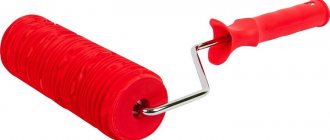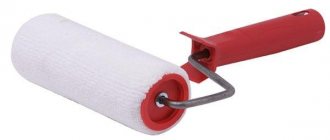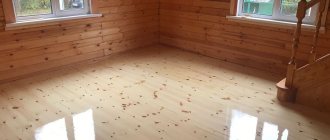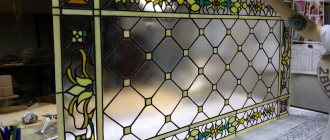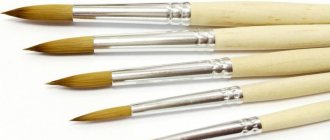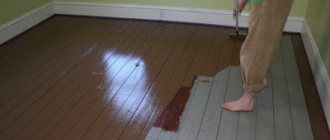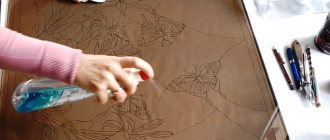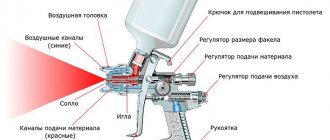Choosing the right roller for water-based paint is the key to quality repairs. Often insufficient attention is paid to this; many people believe that any tool can be used for the job, but this is a misconception. For each coloring composition, there are the most suitable devices that provide the desired result. A mistake in choosing can lead to everything having to be redone.
Paint roller: types
There are paint rollers on the market today that are suitable for different types of repair work and paint products. To choose the right roller for painting with water-based paint, it is better to first pay attention to the material from which the product is made.
To cover the surface with water-based paint, you need a roller consisting of the following materials:
- pile;
- velours;
- foam rubber
Rollers made of different materials are within the same price category, so it is quite difficult for an inexperienced buyer to choose. Don’t hesitate to ask sellers and consultants which roller is better and what operating features are typical for each of them. The material from which the roller is made directly affects what the final painting result will be.
The final result of painting depends on the material from which the roller is made
Operations with different instruments
Painting the ceiling with water-based paint is a process that each master does in his own way, so the result can vary greatly. The work uses brushes, rollers or spray guns.
Painting with a brush
For many, such work is a hello from the Soviet past, but in this case you can’t expect a decent result, since all the stains and strokes will be obvious. Another disadvantage of the method is the excessive consumption of paint, which readily leaves the brush, plopping onto the floor and the artist. Uneven coloring is the reason why some layers contain more water-based emulsion.
This method is applicable in summer cottages, for utility rooms, in workshops or garages, but you must keep in mind that this work will steal at least three times as much time, and for water-based paint this is money, because you need to do it in 20 minutes.
Roller painting
This option, on the contrary, makes it possible to obtain a ceiling without streaks and other defects. They act when dyeing in this now traditional way:
- The junction of the walls and ceiling along the perimeter of the room is sealed with masking tape. All surfaces are protected from water-based paint with polyethylene film.
- Prepare the composition for use: stir or dilute with water, following the manufacturer’s instructions. Experienced craftsmen advise diluting the paint for the first layer a little thinner. Mix the composition with a mixer attachment. The grains that appear on the surface of the paint are removed by filtering the mixture through a triple layer of gauze.
- Use a large brush to paint the joints between the ceiling and the walls and places that are difficult to reach with a roller (for example, heating pipes). Dip the brush into the container a third of the way, be sure to squeeze it against the edge to remove excess, which will not allow you to get a thin layer. Correct the “picture” with a small tool.
- The water-based emulsion is poured into the cuvette, then the roller is moistened (rolled) along its entire length (width) until the entire surface is evenly covered with paint. Apply the water-based emulsion starting from the corner.
- The strip width is a maximum of 50 cm, the overlap is 5-10 cm. The roller handle is held at an angle of 45° to provide better control over the contact of the tool pile with the surface. The quality of work is checked by shining a flashlight onto the area. Or they simply change the viewing angle.
- Any sagging that appears is removed with a used (no longer paint) roller. Marks from overlapping work - with W-shaped movements. The finished surface is left for 12 hours so that the layer is completely dry.
Working with a spray gun
Painting the ceiling with water-based paint using this device is the most enjoyable operation, because it not only guarantees a flawless appearance of the ceiling, but is also quick, easy, and effortless. The process itself looks like this:
- First of all, water-based paint is diluted with water, since the composition for a roller and brush is too thick for this tool. Then the paint must be filtered; this is required by the nozzle, which becomes clogged even with small particles.
- Before you start painting the ceiling, adjust the flow of the mixture. To do this, choose another surface as a target, which is “watered” for about 20-30 seconds. Having stabilized the supply, they move on to painting the ceiling.
- They try to keep the nozzle perpendicular to the plane being processed, the distance from it to the tool is about 50 cm. They control the pace and speed of painting; 1 m2 in 5 seconds is considered ideal.
- Painting is carried out in squares: movement in one direction is alternated with a transverse direction, then move on to the next section. Delays are avoided, because such a mistake will result in a thicker layer of water-based emulsion. In this case, underpainting is much better, since it will subsequently be reliably hidden by the second layer. Their optimal number is 3.
Painting a ceiling with water-based paint is an activity that can hardly be called super-complicated, and a decent result will be ensured by premature acquaintance with the peculiarities of the work and potential mistakes that can be easily avoided.
The following video will show you how this work works:
From foam rubber
The main advantage of using foam rollers for applying water-based paint is their low cost, as well as the ability to purchase them at any, even the smallest, repair store. One roller can be made from several types of foam rubber.
Pay attention to the percentage of high-density foam rubber, it is this that ensures resistance to mechanical stress.
However, foam rubber products have their disadvantages:
- the roller absorbs more paint than necessary, which is unprofitable from the point of view of rational use of materials;
- Due to excessive impregnation of foam rubber with water-based paint during work, a large number of bubbles may form on the surface and the coating will be uneven.
The main advantage of foam rollers is their low cost.
Preparatory work
To carry out repair work, painters have recently given preference not to disposable rollers, but to the monolithic structure of the drum and clasp (the so-called handle and axis on which the drum is attached). And instead of a disposable product, covers made of various materials are used, which are changed as needed. The principle of choice here is the same as with disposable rollers. The materials that are most commonly used are discussed above.
The most typical situation: the plaster from the ceiling has fallen off in parts, the corners have darkened, but the entire structure has no specific damage or distortions in the horizontal plane. In this case, you first need to get rid of the old whitewash and plaster by wetting the old layer with plain water from a spray bottle. To remove it, you need to use a regular metal spatula, which is found in almost every home.
You need to spray water 10-20 minutes before starting work so that it is absorbed and the plaster peels off more easily.
If there was wallpaper or something similar on the surface, then they should also be cleaned along with the adhesive layer.
So now you have a blank canvas to paint. But before you open a can of paint, you need to do a lot of physical movements. To successfully work with the ceiling in a typical room of a Soviet-era building, several layers of primer are used. And the first layer is aseptic. In some cases, the surface is additionally disinfected with chlorine and similar means - here everything depends on the specific situation.
The primer must be compatible with the paint. After disinfection, a so-called primer is applied to the surface - a primer polymer composition. After it dries, you can move on to putty.
It should be clarified that the polymer primer layer requires several sanding procedures and intermediate work. Therefore, it would be correct to strictly adhere to the following sequence of actions:
A layer of starting putty is applied. The consumption of the composition at this stage is approximately 3 kilograms per 1 square meter. meter of area. The surface is sanded. The starting compound is applied to those areas where it was not enough after rough sanding. It is necessary to apply a thin layer of finishing putty to the ceiling surface. Here the consumption of the composition is 1 kilogram per 1 sq. meter of ceiling. Then you need to complete the final grinding of the surface using sandpaper.
Made from velor
It is advisable to choose such a roller for painting a flat, smooth surface. Velor is a synthetic material and products made from it are much cheaper than, for example, mohair rollers. Another undoubted advantage of velor rollers is their resistance to aggressive solvents.
However, the inconvenience in using this type of product is that velor does not absorb water-based paint well. In order to achieve an even, uniform coating, you will have to dip the tool into the coloring solution too often, which creates a lot of inconvenience for the painter.
Polyamide or velor
The advantage of velor fur coats is their resistance to chemical components of paints and varnishes. Rollers can be used with any dyes, including emulsions for painting ceilings.
A tool with a velor coat is convenient because when using it, the paint not only does not splash, but also does not roll off. The only drawback of the devices is the rapid absorption of liquid and the need to repeatedly lower the roller into the paint tray.
The polyamide version of the device is a textile pillow stitched with strong threads. Its main area of application is decorative work, during which you need to ensure that the paint does not splash around.
fleecy
Pile rollers are best suited for painting with water-based paint. In order to determine what length of pile should be chosen, you need to clearly know the characteristics of the surface to be painted. For hard surfaces, it is better to purchase products with long pile.
If you are not well versed in the intricacies of painting, then buying a product with a medium length of pile would be a win-win option.
The material directly affects the cost. Rollers made from natural fur or felt will cost more than those made from artificial substitutes. The quality of the fur coat material determines what the painting result will be, so you should not skimp.
Pile rollers are an ideal option for painting with water-based paint
Advantages of pile rollers:
- the ability to correct paint absorption using different lengths of pile: by choosing a roller with long pile, you can immediately cover the surface with water-based paint with a thick layer, and in order for the layer to be thin, you can purchase a product with short pile;
- Carrying out decorative painting work: rollers with short pile are best suited for such purposes;
- the natural material of the fur coat ensures long-term use;
- A long-nap roller is essential for ensuring even coverage on rough and porous surfaces.
Coloring Tips
There are rules that must be followed when painting wallpaper for painting. If the established technology is followed, the coloring result meets the owners’ expectations and is maintained until the next repair.
Tips for those who decide to paint the walls themselves:
- Paint should not be applied to wet wallpaper. Therefore, you need to wait until the newly pasted canvases are completely dry and only then start painting.
- Since the wallpaper is initially white, it can be painted any shade.
- When diluting paint, you must strictly follow the recommended proportions and remember the amount of pigment added. If this is not done, the next time you dilute it you will not be able to achieve the desired color, and the work will be ruined.
- To protect baseboards and ceilings from paint contamination, use masking tape.
- The canvas must be painted in one go, maintaining the same direction of movement of the roller and pressure force. Otherwise, spots and streaks will appear after the paint dries.
- You can avoid the appearance of streaks if you follow the following painting sequence: first, use a brush to go through the corners, areas near the baseboard and ceiling; then the paint is applied with a roller, moving without skipping from top to bottom.
- The next layer of paint is applied after the previous one has dried, usually two layers are sufficient.
- Wallpaper can be painted in several colors: a combination of different shades is used to give the interior an individual style. Different colors are combined on one wall or each wall is painted a different color. By skillfully using color combinations, you can hide the shortcomings of a room: for example, horizontal color stripes visually expand it, vertical stripes are used in rooms with low ceilings. A color accent on one wall is used to zone rooms in one-room apartments and studio apartments.
Wallpaper for coloring makes it possible to create a new unique interior, to embody the most daring design ideas with your own hands without significant expense and effort. If you don’t like the result, there is always the opportunity to repaint it and make it better than it was!
Other selection criteria
Having decided on the type and material of the fur coat, you should not immediately rush to the checkout. The quality of paint work is also affected by the size of the paint rollers. If you have a fairly significant amount of work awaiting you and there are several types of surfaces, then you are unlikely to be satisfied with one roller of a certain size.
Before purchasing you need to check:
- The quality of the seams on the fur coat. The accuracy and smoothness of the seam determines how evenly the paint will be distributed over the surface. Rough seams indicate poor quality of the product and will leave marks on the painted surface.
- For linty products, it is advisable to carry out the following check: lightly squeeze the lint with your fingers and pull it towards you. If the material is of high quality, the lint will not fall out. If after checking you notice that the pile is easy to pull out, then it is better to choose another product.
- For ease of use, the handle is of great importance. It should be comfortable, easy to squeeze and not slip in your hand. For painting walls or ceilings, it is desirable that the handle can be extended.
- Some manufacturers also offer a set of replacement fur coats. This is very convenient for practical use. If a tool is damaged during paintwork, its coat can be replaced immediately. The cost of the product is much higher than that of products with glued fur coats, however, if the handle wears out, replacement of the handle is not required.
- There are also rollers with stops and regulators. The availability and quality of auxiliary parts affects the price category of the product.
When choosing a size, it is better to be guided by the principle of correspondence - the larger the surface, the larger the tool and vice versa. Also keep in mind that when impregnated with paint, the roller will become much heavier. This is important to understand to ensure the convenience of the upcoming work.
How to choose and prepare paint
There are different water-based compositions. Each of them has features that will need to be taken into account when choosing paint:
- Acrylic. This water-based emulsion is good because it allows you to get a smooth surface, hiding small defects, such as small bulges or cracks. It serves for a long time and has low consumption when painting. Acrylic paints are suitable only for dry rooms, but they are resistant to wet cleaning. The disadvantage of acrylic is the high price, as well as the impossibility of painting a poorly dried surface.
- Silicates. This coating is resistant to moisture and is suitable for external work, for whitewashing ceilings on balconies and verandas.
- Mineral water emulsions. Such compositions adhere to any surface without problems, but are also easily washed off, so wet cleaning is not available for surfaces painted with mineral emulsion. These paints are the cheapest.
- Silicone. Such paints are attractive because they allow you to get a smooth ceiling even without careful preparation. Silicone emulsion can mask cracks up to 2 mm. It is suitable for ceilings in bathrooms and other wet areas. The disadvantage is the high cost.
Based on the characteristics of the listed compositions, you can choose exactly the one that is most appropriate for painting the ceiling in a particular room. By color you can choose matte, semi-matte, glossy or semi-gloss water-based emulsion. There are instructions on the paint container that outline the work procedure. Some paints require dilution with water, others just need to be stirred.
If the emulsion is diluted with water, this happens gradually. After adding water, everything is mixed, and then the resulting composition is tested on a small area of the surface.
Preparation
The paint, as when applying it with a roller, is thoroughly mixed beforehand. In this case, it is necessary to absolutely eliminate the presence of lumps in the mixture. If they remain, they can clog the spray gun and the mixture will go unevenly. If it is intended to give the composition any shade, color is added during mixing. You need to pour it in small portions. It is unacceptable to leave pigment stains in the paint. The composition must be homogeneous. Experienced craftsmen advise preparing paint with a reserve, because if it runs out and the surface is not completely covered, then it may not be possible to choose a perfectly accurate tone.
